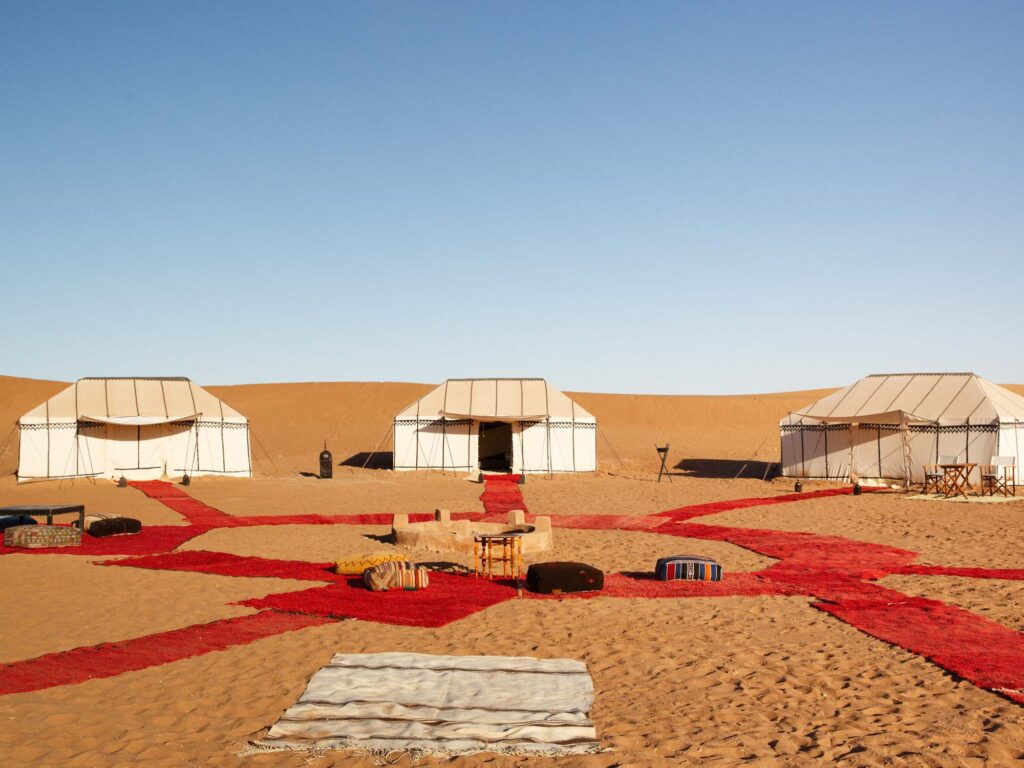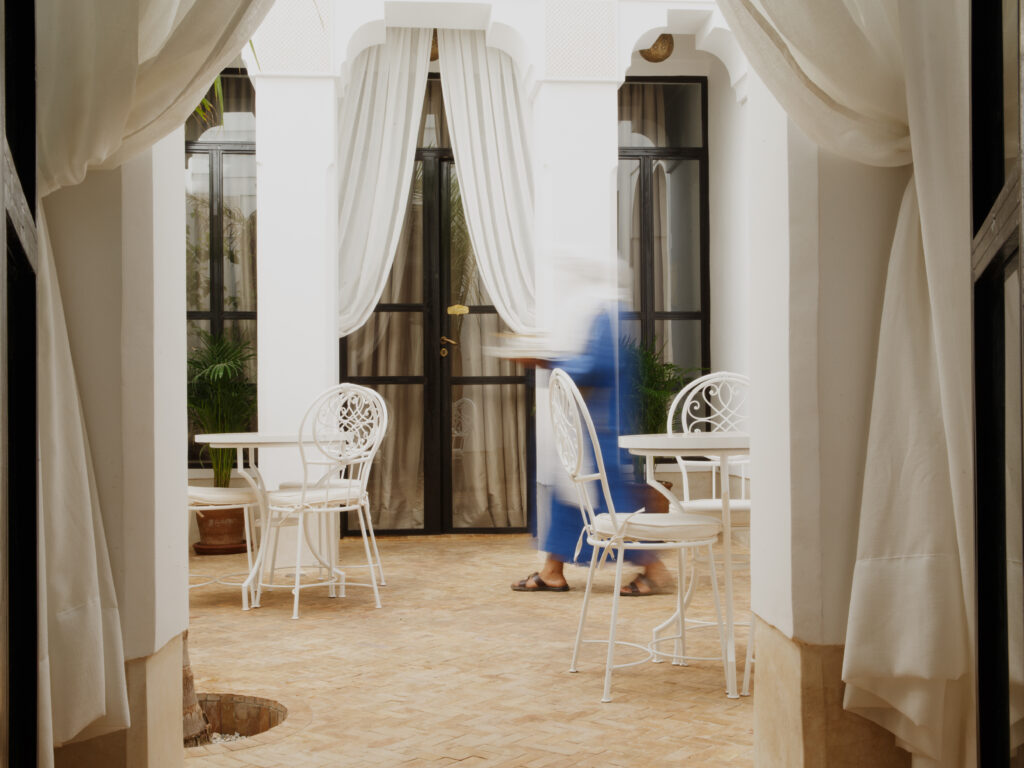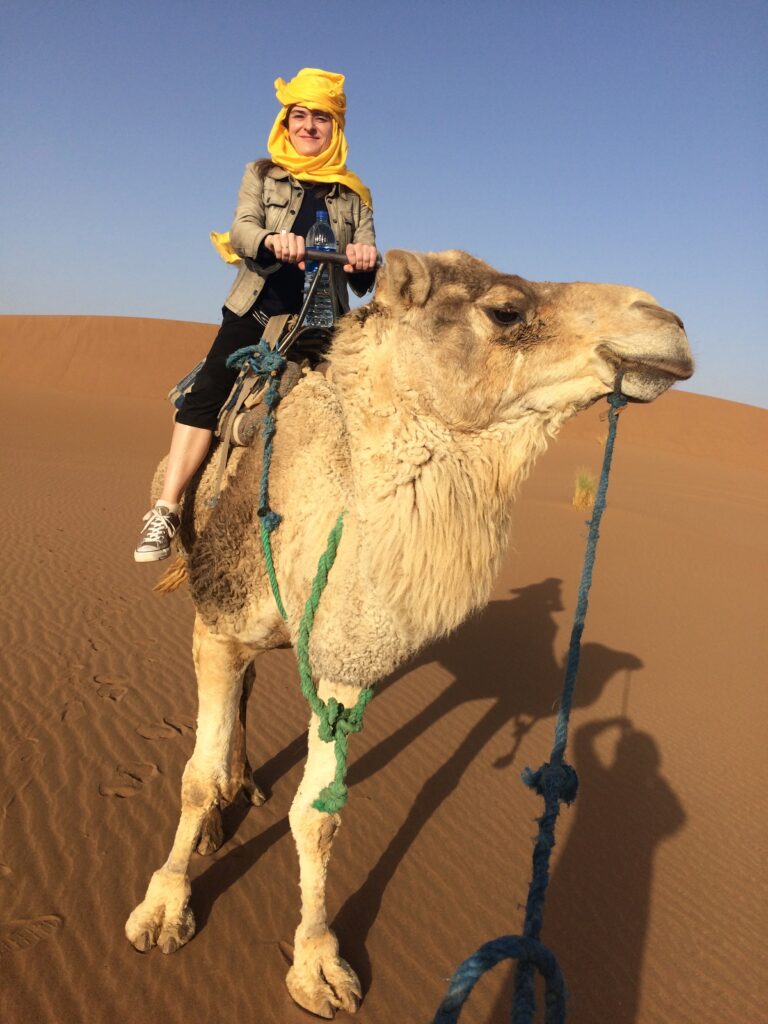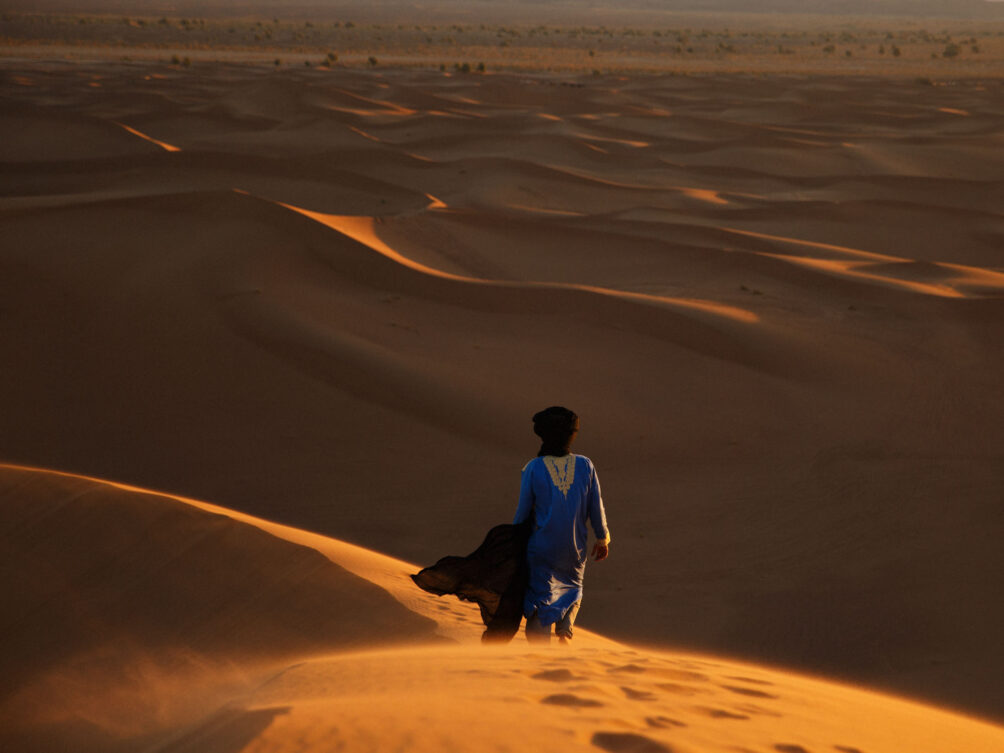The sun is rising over the Sahara and I’m wrapped in a blanket to watch it. It’s spring in Morocco so night time and early mornings are chilly but by afternoon temperatures reach the high 20s and the sand is almost too hot to walk on.
I’m rocking in a hammock outside my tent at the Nubia Luxury Camp – just eight tents at the foot of the immense drifting sand dunes of Erg Chebbi, the romantic views of every desert-set film you’ve ever seen. But these are no ordinary tents. If a famous drinks company did tents this is what they would create, kitted out with king-sized beds, electricity and running water – yes, that does mean flushing toilets. There’s a ‘lounge’ tent with cosy couches and a fully fitted dining area, but it’s much more fun to eat outside, having breakfast as the sun rises or dinner beside the campfire, candlelit lanterns flickering around the sand dunes.

Breakfast this morning includes a date syrup that is part of the traditional Berber breakfast, eaten with olives and bread, Lahsen, who serves it, tells me. Though it’s unlikely the Berbers went on to eat an omelette, several pancakes and granola served with coconut fruit yoghurt, as I did, as well as a basket of bread accompanied with three different types of jam, a dish of honey and a bowl of chocolate spread.
Who are the Berbers?
According to local folklore, the Berbers are descended from the children of Adam and Eve and are the earliest settlers in Morocco. Though “settlers” isn’t probably the best way to describe these nomadic tribes. And Lahsen knows their customs very well, being one of them. The Nubia Camp is run by local Berbers, employed by the Beldi Collection which owns it. Many of the tribes are now settling in villages and towns around the edge of the desert, Lahsen tells me, wanting to find work and educate their children.
But nomadic tribes do still travel the Sahara and later that day I meet some of them, visiting nomads Ali and Hra at their desert camp. Spread out across several hundred feet of rocky sand, it has several separate tents and wooden shelters, a space for showering and a lush green garden.
There’s a joyful reunion during my visit between Ali and somebody I assume is a desert local, until I get talking to him later and find out he’s a biker from Berlin, who’s made the trip by motorcycle from his adopted home in Greece for the past three years and is now firm friends with Ali.
Ali and Hera are entertaining us in their ‘living room’ tent, where they also sleep, serving us mint tea and later lunch – platters of barbecued meat, roasted vegetables and salad. Food is one of the greatest joys of visiting Morocco and for dinner back at the camp, chef Omar feeds me delicious lamb tagine with dates, chicken roasted with lemon and vegetable couscous. These are the sorts of dishes I determine to recreate at home as I wrap a tagine in several layers of clothes to protect it in my suitcase, knowing deep down that it’s unlikely to happen unless I pack the star-filled Moroccan sky and a bit of the Sahara as well.
Camp Nubia is a 9-hour drive from Marrakesh, allowing for several stop-offs for tea, photographs and the bathroom, and a leisurely hour and a half break at the Riad Dar Sofian – an oasis within a literal oasis, where lunch is served around a palm-fringed pool.
Back to the Riad Louhou
Flying into Marrakesh from the UK is like flying into the 1001 Arabian Nights, with its exotic domed roofs, red towers and turrets. It’s a city of souks and palaces, mosques and the medina, which is the old part of the city where I’m staying in a riad, a traditional Moroccan house with a central courtyard.

The Riad Louhou is also owned by the Beldi Collection, each of its five bedrooms overlooking the traditional courtyard. What’s not so traditional is the pool on the roof terrace, making it an attractive choice, you can also eat up here at one of the al fresco tables or under luxurious draped curtains in the shade.
It’s an easy walk from here to the souks, the labyrinthine network of lively markets selling everything from food to furniture, where light filters through in small openings to keep the setting cool and a bit mysterious. No space for cars, just travellers on foot, riders on scooters and the occasional donkey pulling a cart. Heavy loads are carried by scooter, from the weekly grocery shop to a mound of cut branches still bearing oranges, and one man who nonchalantly drove through the media balancing – I kid you not – four dozen eggs on his knee.
You can find everything from gleaming brass lanterns to colourful jars of olives, fabrics and glassware, china and silver, slippers and handbags, silks, leathers, beads, metalwork and more, as well as several winding streets of workshops where you can see the artisans at work. I go with a guide, Mustapha, and so I’m not hassled by the sellers at all, in fact I sort of get to hang out with them as Mustapha frequently stops to greet people he knows with lots of hugs and touching of hearts.
What else to see in Marrakesh
He also takes me to see the mausoleum, built for the 16th century Saadian dynasty, grand burial rooms richly decorated with glittering mosaics and Carrera marble, ceilings carved from molten gold. And more richness at the lavish Moorish 150-roomed Bahia Palace, built in the 19th century for the sultan and his harem by 100 master craftsmen from Fez, on a site covering 8 hectares, with its stucco work, fine filigree and beautiful arabesque ceilings.
As a woman travelling alone, I’m looked after very well by Youssef, my driver and guide from Marrakesh to the Sahara. Nobody hassles me but I do get asked a few times if I am really travelling by myself, with several worried enquiries about the existence of a family back in the UK, so they can reassure themselves I’m not an orphan wandering the world alone.
Crossing the Sahara
The journey Youssef takes me on to the Sahara follows the ancient caravan route from Marrakech through the stunning landscapes of the High Atlas Mountains, through Berber villages and the lush green Draa Valley. The views are stupendous, across red mountain ranges and into redbrick towns, through olive trees and cactus plants, passing men riding donkeys and children waiting for school buses. The last two hours are off-road through the desert, bumping across sand dunes and stones, but the destination is worth it, a Sahara camp just before sunset.
And then sitting on a camel, I’m led across the sand by Sakaria from the camp, to watch the sun go down from one of the highest dunes. This is bucket list stuff that everyone should get the chance to try at least once in their lifetime.

I love the fact I’ve become someone who gets up to watch the sunrise and travels an hour to see the sun set, things I wouldn’t contemplate for a minute doing at home – though in fairness, you’d be hard pressed to find a camel in Croydon.
But this is one of the joys of holidays, the space and the freedom to step outside of your routine and do different things, a chance for a while to be somebody else. Or maybe, just for a while, a more open, more interesting, more inspired version of yourself.
Information and contacts
Double rooms at the Riad Louhou £130, suites £150. Nubia Luxury Camp B&B £160 per person per night, half board for one-night, full board for 2 nights or more. Phone UK: 0044 (0)1223 968178, email stay@thebeldicollection.com, www.thebeldicollection.com

